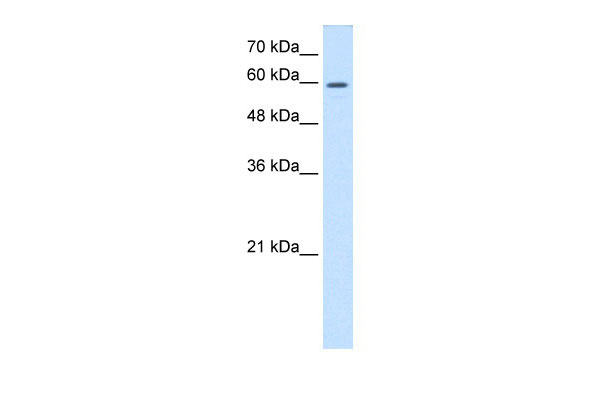CRMP1 antibody - C-terminal region
Rabbit Polyclonal Antibody
- 产品详情
- 实验流程
Application
| WB |
|---|---|
| Primary Accession | Q14194 |
| Other Accession | NM_001313, NP_001304 |
| Reactivity | Human, Mouse, Rat, Rabbit, Zebrafish, Dog, Horse, Bovine |
| Predicted | Human, Mouse, Pig, Chicken, Dog, Horse, Bovine |
| Host | Rabbit |
| Clonality | Polyclonal |
| Calculated MW | 62184 Da |
| Gene ID | 1400 |
|---|---|
| Alias Symbol | DPYSL1, DRP-1, DRP1, CRMP-1, ULIP-3 |
| Other Names | Dihydropyrimidinase-related protein 1, DRP-1, Collapsin response mediator protein 1, CRMP-1, Unc-33-like phosphoprotein 3, ULIP-3, CRMP1, DPYSL1, ULIP3 |
| Format | Liquid. Purified antibody supplied in 1x PBS buffer with 0.09% (w/v) sodium azide and 2% sucrose. |
| Reconstitution & Storage | Add 50 ul of distilled water. Final anti-CRMP1 antibody concentration is 1 mg/ml in PBS buffer with 2% sucrose. For longer periods of storage, store at 20°C. Avoid repeat freeze-thaw cycles. |
| Precautions | CRMP1 antibody - C-terminal region is for research use only and not for use in diagnostic or therapeutic procedures. |
| Name | CRMP1 |
|---|---|
| Synonyms | DPYSL1, ULIP3 |
| Function | Necessary for signaling by class 3 semaphorins and subsequent remodeling of the cytoskeleton (PubMed:25358863). Plays a role in axon guidance (PubMed:25358863). During the axon guidance process, acts downstream of SEMA3A to promote FLNA dissociation from F-actin which results in the rearrangement of the actin cytoskeleton and the collapse of the growth cone (PubMed:25358863). Involved in invasive growth and cell migration (PubMed:11562390). May participate in cytokinesis (PubMed:19799413). |
| Cellular Location | Cytoplasm. Cytoplasm, cytoskeleton, microtubule organizing center, centrosome. Cytoplasm, cytoskeleton, spindle. Cell projection, growth cone {ECO:0000250|UniProtKB:P97427}. Cytoplasm, cytoskeleton {ECO:0000250|UniProtKB:P97427}. Perikaryon {ECO:0000250|UniProtKB:P97427}. Note=Associated with centrosomes and the mitotic spindle during metaphase (PubMed:11562390). Colocalizes with FLNA and tubulin in the central region of DRG neuron growth cone (By similarity). Following SEMA3A stimulation of DRG neurons, colocalizes with F-actin (By similarity) {ECO:0000250|UniProtKB:P97427, ECO:0000269|PubMed:11562390} |
| Tissue Location | Brain. |
Research Areas
For Research Use Only. Not For Use In Diagnostic Procedures.
Application Protocols
Provided below are standard protocols that you may find useful for product applications.
REFERENCES
Stelzl,U., (2005) Cell 122 (6), 957-968 Reconstitution and Storage:For short term use, store at 2-8C up to 1 week. For long term storage, store at -20C in small aliquots to prevent freeze-thaw cycles.
终于等到您。ABCEPTA(百远生物)抗体产品。
点击下方“我要评价 ”按钮提交您的反馈信息,您的反馈和评价是我们最宝贵的财富之一,
我们将在1-3个工作日内处理您的反馈信息。
如有疑问,联系:0512-88856768 tech-china@abcepta.com.























 癌症的基本特征包括细胞增殖、血管生成、迁移、凋亡逃避机制和细胞永生等。找到癌症发生过程中这些通路的关键标记物和对应的抗体用于检测至关重要。
癌症的基本特征包括细胞增殖、血管生成、迁移、凋亡逃避机制和细胞永生等。找到癌症发生过程中这些通路的关键标记物和对应的抗体用于检测至关重要。 为您推荐一个泛素化位点预测神器——泛素化分析工具,可以为您的蛋白的泛素化位点作出预测和评分。
为您推荐一个泛素化位点预测神器——泛素化分析工具,可以为您的蛋白的泛素化位点作出预测和评分。 细胞自噬受体图形绘图工具为你的蛋白的细胞受体结合位点作出预测和评分,识别结合到自噬通路中的蛋白是非常重要的,便于让我们理解自噬在正常生理、病理过程中的作用,如发育、细胞分化、神经退化性疾病、压力条件下、感染和癌症。
细胞自噬受体图形绘图工具为你的蛋白的细胞受体结合位点作出预测和评分,识别结合到自噬通路中的蛋白是非常重要的,便于让我们理解自噬在正常生理、病理过程中的作用,如发育、细胞分化、神经退化性疾病、压力条件下、感染和癌症。






